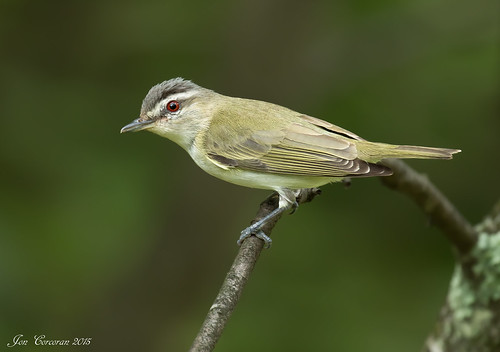Red-eyed Vireo
(Vireo olivaceus)
Conservation • Description • Habitat • Ecology • Distribution • Taxonomy
|
|
||||||||||||||
Description |
Red-eyed Vireo small perching songbird is relatively large for a vireo. It is the most common and widespread vireo in Minnesota. It is about 6″ in length, has a10″ wingspan, and weighs about 0.63 ounces. The upper parts are olive green. The breast, belly, and throat are white to pale gray. The flanks and undertail coverts are yellowish. The wings are not barred. The crown is gray and is edged with black. There is a dark gray line through the eye that extends forward to the bill and a white “eyebrow” line above that. The irises of adults are dark red, though this is apparent only at close range. The cheek is olive. The legs are bluish-gray. |
Size |
6″ in length 10″ wingspan |
Voice |
|
|
The song of the male is a continuous, variable series of short phrases separated by short pauses. It sounds similar to a robin but is not as loud and is more variable. |
Similar Species |
Philadelphia Vireo (Vireo philadelphicus) has a yellow breast. The gray crown is not bordered with black. Warbling Vireo (Vireo gilvus) dark eye line does not extend forward to the bill. The gray crown is not bordered with black. |
Habitat |
Deciduous and mixed woodlands with a dense cover and a shrubby understory |
Ecology |
Migration |
Early May to mid-October |
Nesting |
The female builds a cup-shaped nest in the crook of a tree branch. When the nest is completed and lined she lays 3 to 5 eggs. The eggs are white and are spotted at the large end. She incubates the eggs 11 to 14 days. The nest building and incubation are done without the help of the male. After the eggs hatch both the male and the female feed the nestlings. The young leave the nest in 10 to 12 days. |
Food |
Insects, especially caterpillars, and berries. |
Distribution |
Occurrence |
Common to abundant migrant and breeder |
Maps |
The Minnesota Ornithologists’ Union All Seasons Species Occurrence Map |
Taxonomy |
|
Class |
Aves (birds) |
Order |
Passeriformes (perching birds) |
Family |
Vireonidae (greenlets, vireos) |
Genus |
Vireo (vireos) |
Subordinate Taxa |
|
|
|
Synonyms |
|
|
|
Visitor Photos |
||
Share your photo of this bird. |
||
This button not working for you? |
||
Bill Reynolds |
||
 |
||
MinnesotaSeasons.com Photos |
||
|
||
|
||

Slideshows |
Red-eyed Vireo (Vireo olivaceus) |

|
Red-eyed Vireo |

|
Red-eyed Vireo |

|
Canto da Juruviara (Vireo olivaceus) |
About
Published on May 11, 2013 A juruviara (Vireo olivaceus) é uma ave passeriforme da família dos vireonídeos, nativas das matas da América do Sul. Tais aves chegam a medir até 14 cm de comprimento e, ao contrário de sua variante norte-americana, possuem a íris marrom ou acinzentada. Além disso, possuem ainda uma plumagem esverdeada com píleo cinzento e sobrancelha branca margeada de negro. Também são conhecidas pelo nome de trinta-e-um. |

Visitor Videos |
||
Share your video of this bird. |
||
This button not working for you? |
||
|
Other Videos |
||
| Red-eyed Vireo (Vireonidae: Vireo olivaceus) Immature, Close-up Carl Barrentine |
About
Published on Sep 23, 2012 One of many Fall migrant species passing through North Dakota just now. Photographed at Grand Forks, North Dakota (23 September 2012). |

|
Created: Last Updated: © MinnesotaSeasons.com. All rights reserved. |


